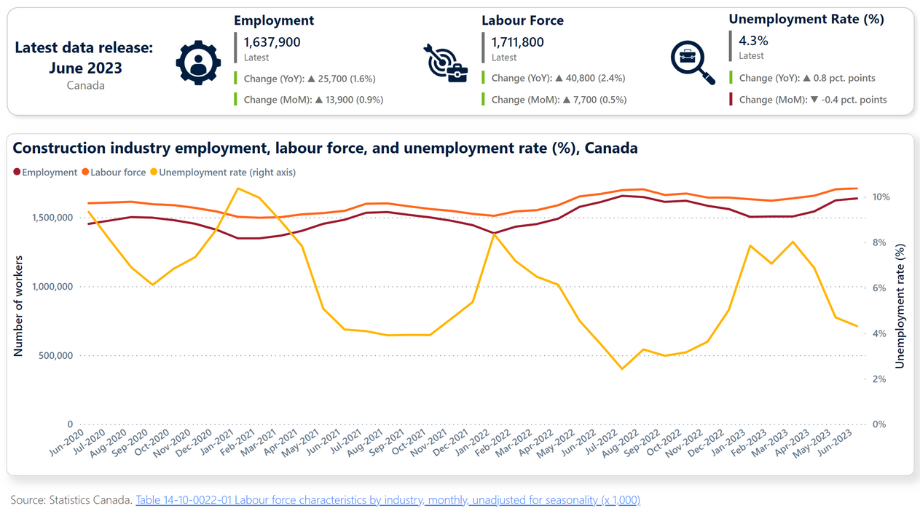The latest Labour Force Survey (LFS) data from Statistics Canada shows that national, all-industry employment rose by 60,000 (+0.3%) in June.
The advance was driven by gains in full-time work (+110,000, +0.7%). Employment gains were most significant among young men aged between 15 and 24 years and among those in the core working-age demographic of between 25 and 54 years. Both groups added 31,000 workers for the month; since March, employment in the core working age group among men has risen by 92,000.
Employment was almost unchanged among women in all age groups.
The national, all-industry unemployment rate rose by 0.2 percentage points in June, following a similar increase in May. The increase brought the rate to 5.4%, which is its highest reported level since February 2022. Despite these increases, the national unemployment rate remains below its pre-COVID-19 pandemic average of 5.7% that was recorded in the 12 months leading up to February 2020.
Statistics Canada collected data for the June LFS during the week of June 11 to 17.
Construction labour force, employment figures reach new highs
Construction, meanwhile, continues to report significant labour market gains, with the prospect of another challenging summer in store.

Seasonally unadjusted increases in both employment (+14,000, +0.9%) and the labour force (+7,600, +0.4%) in June propelled the sector to new highs of 1.638 million and 1.712 million, respectively. The sector is now approaching manufacturing as the largest component of the good-producing industries.
As a result of these changes, the industry’s unemployment rate declined from 4.7% to 4.3%.
Over the past 12 months, industry employment has grown by 25,700, or 1.6%, while the labour force has increased by 40,800, or 2.4%. This suggests the industry’s efforts to recruit more workers may be bearing fruit. Construction’s unemployment rate, meanwhile, has increased from 3.5% in June 2022 to 4.3% in June 2023.
Particularly strong gains are being seen in the number of women joining the construction labour force. The number of women in the construction labour force increased by over 25,000 compared to June 2022. The male labour force increased by 15,500 workers.
Central Canada, specifically Quebec and Ontario, has been the principal driver of employment and labour force growth in the construction sector over the past 12 months. The provinces reported growth of 20,600 and 12,400 in their respective employment figures since June of 2022, and of 20,200 and 16,300 in their respective labour forces over the same period. Alberta and Manitoba were the only other provinces to report employment and labour force gains over the same period, while Saskatchewan (-8,200 and -7,100) and Nova Scotia (-6,100 and -5,900) reported the sharpest contractions in employment and labour force levels.
On a monthly basis, Quebec (7,000) and Ontario (5,600) again reported the largest gains in employment figures, with Alberta reporting the next-largest gain at 4,000. Gains reported in other provinces were between 1,300 and 300. Only two provinces reported employment contractions in June: Newfoundland and Labrador at -200 and British Columbia at -4,700. Labour force gains in June were largest in Alberta (6,900) and Quebec (3,600). Three provinces reported nearly unchanged figures for the month, while British Columbia reported a contraction of -3,600.
Across the provinces, unemployment remained highest in Newfoundland and Labrador at 18.2%, the only province to report double-digit figures. The other provinces reported rates of between 9.2% (New Brunswick) and 2.6% (Quebec).


Construction Key Indicators
